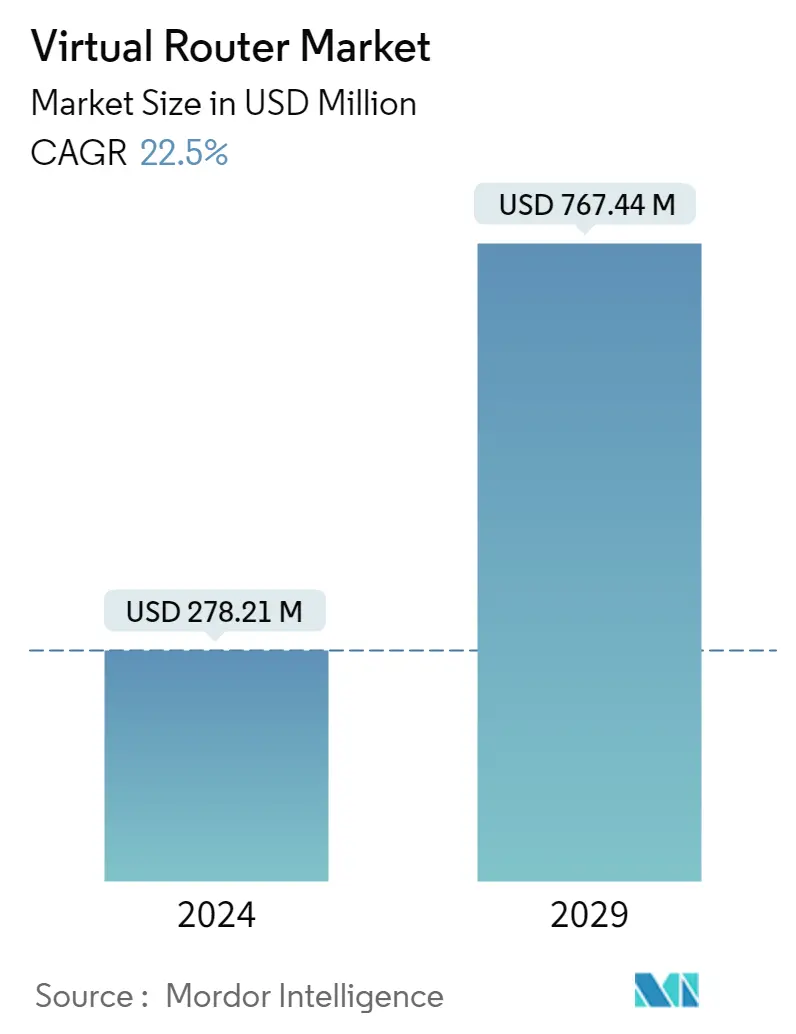Market Size of Virtual Router Industry

| Study Period | 2019 - 2029 |
| Market Size (2024) | USD 278.21 Million |
| Market Size (2029) | USD 767.44 Million |
| CAGR (2024 - 2029) | 22.50 % |
| Fastest Growing Market | Asia Pacific |
| Largest Market | North America |
Major Players
*Disclaimer: Major Players sorted in no particular order |
Virtual Router Market Analysis
The Virtual Router Market size is estimated at USD 278.21 million in 2024, and is expected to reach USD 767.44 million by 2029, growing at a CAGR of 22.5% during the forecast period (2024-2029).
The virtual router market is driven by the increasing demand from the telecommunication and enterprise sector as service providers are increasingly moving from expensive, dedicated hardware devices to virtualized solutions that reduce the total cost of ownership (TCO), flexibility, and scalability.
- The increasing focus on software-defined networking (SDN) has led to the development of several advanced virtual router software solutions. Moreover, the growing demand for private cloud and virtual router applications across network segments in the telecommunication and enterprise sector is expected to provide significant growth opportunities in the market.
- Further, in the past few years, enterprise services have been becoming more diversified; more and more enterprises have deployed virtual private clouds (VPCs) on public or private clouds to cloudification and virtualize enterprise networks and IT infrastructure, thereby reducing network costs and implementing fast service rollout. Such factors increase the demand for cost-effective solutions such as Virtual routers in end-user segments owing to their scalability and cost-effective features.
- Additionally, as cloud-based services develop, applications and traffic surge rapidly. Traditional enterprise WANs face challenges in enterprise infrastructure and service cloudification requirements. Virtual routers cope with trends of network device cloudification and virtualization. In addition, virtual routers save hardware costs because no dedicated hardware platform is required. Such developments resulted in virtual routers gaining significant traction in the past few years, expanding the virtual router market.
- Moreover, the rising need for private clouds in enterprises coupled with expanding popularity of cloud services is creating growth opportunities for the market over the forecast period. These cloud services are strengthening their operations via the deployment of virtual routers, consequently fostering market growth. The need for virtual routers has significantly increased in the network environment due to their favorable features, which include faster data acquisition, faster network speed increases, and safer storage networks, among others, for cloud services.
- Most industries faced difficulties as a result of the COVID-19 pandemic. Governments across the world forced indefinite shutdowns and disrupted supply chains. Businesses attempted to reduce maintenance costs across network environments, thus increasing the demand for virtual routers to reduce the total cost of ownership. Moreover, the market is expected to witness significant demand post-pandemic owing to the high penetration of digitization and cloud services and innovations in the virtual router environment.
Virtual Router Industry Segmentation
A Virtual Router is a software function that replicates in software the functionality of a hardware-based Layer 3 Internet Protocol (IP) routing, which has traditionally used a dedicated hardware device.
The Global Virtual Router Market is segmented by Component (Solution and Service), End-User (Service Providers, Enterprises), and Geography (North America, Europe, Asia-Pacific, Rest of the World).
The market sizes and forecasts are provided in terms of value (USD) for all the above segments.
| By Component | |
| Solution | |
| Service |
| By End-User | |
| Service Provider | |
| Enterprise |
| By Geography | ||||||
| ||||||
| ||||||
| ||||||
|
Virtual Router Market Size Summary
The virtual router market is experiencing significant growth, driven by the increasing demand from the telecommunications and enterprise sectors. As service providers transition from costly, dedicated hardware to virtualized solutions, the market is benefiting from reduced total cost of ownership, enhanced flexibility, and scalability. The rise of software-defined networking (SDN) has spurred the development of advanced virtual router software solutions, creating substantial growth opportunities. The demand for private cloud and virtual router applications is expanding across network segments, further propelling market expansion. The trend towards cloudification and virtualization of enterprise networks and IT infrastructure is also contributing to the increased adoption of virtual routers, as they offer cost-effective solutions with scalable features.
Service providers, including data centers, telecom, and cloud companies, are expected to hold a significant share of the market due to the growing deployment of SDN and virtual network functions (VNF). These providers are leveraging virtual routers to transform their network infrastructure, build consumer-centric business models, and enhance operational efficiency. The ability of virtual routers to scale bandwidth rapidly makes them ideal for accommodating increasing data demands, particularly with the growth of fiber and 5G technologies. The North American region is anticipated to dominate the market, supported by advancements in networking technology and significant investments from key companies. The region's highly developed internet infrastructure and the adoption of advanced network technologies like 5G are expected to drive further demand for virtual routers.
Virtual Router Market Size - Table of Contents
-
1. MARKET INSIGHTS
-
1.1 Market Overview
-
1.2 Industry Attractiveness - Porter's Five Forces Analysis
-
1.2.1 Bargaining Power of Buyers/Consumers
-
1.2.2 Bargaining Power of Suppliers
-
1.2.3 Threat of New Entrants
-
1.2.4 Threat of Substitute Products
-
1.2.5 Intensity of Competitive Rivalry
-
-
1.3 Assessment of the Impact of the COVID-19 on the Market
-
-
2. MARKET SEGMENTATION
-
2.1 By Component
-
2.1.1 Solution
-
2.1.2 Service
-
-
2.2 By End-User
-
2.2.1 Service Provider
-
2.2.2 Enterprise
-
-
2.3 By Geography
-
2.3.1 North America
-
2.3.1.1 United States
-
2.3.1.2 Canada
-
-
2.3.2 Europe
-
2.3.2.1 United Kingdom
-
2.3.2.2 Germany
-
2.3.2.3 France
-
2.3.2.4 Rest of Europe
-
-
2.3.3 Asia-Pacific
-
2.3.3.1 China
-
2.3.3.2 Japan
-
2.3.3.3 India
-
2.3.3.4 Rest of Asia-Pacific
-
-
2.3.4 Rest of the World
-
2.3.4.1 Latin America
-
2.3.4.2 Middle-East & Africa
-
-
-
Virtual Router Market Size FAQs
How big is the Virtual Router Market?
The Virtual Router Market size is expected to reach USD 278.21 million in 2024 and grow at a CAGR of 22.5% to reach USD 767.44 million by 2029.
What is the current Virtual Router Market size?
In 2024, the Virtual Router Market size is expected to reach USD 278.21 million.

